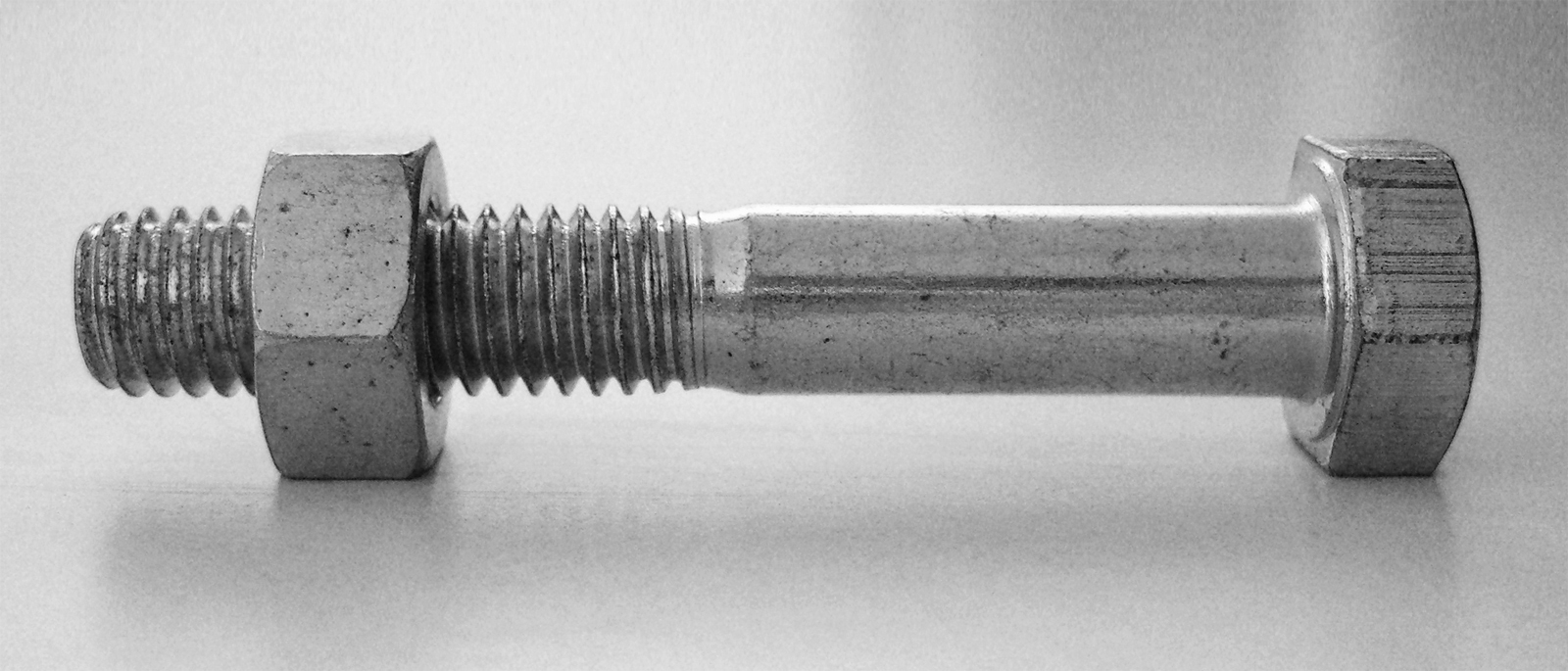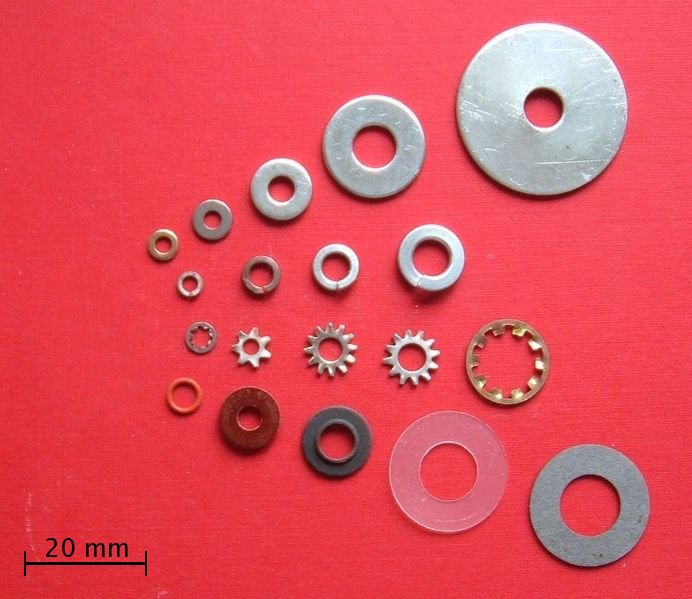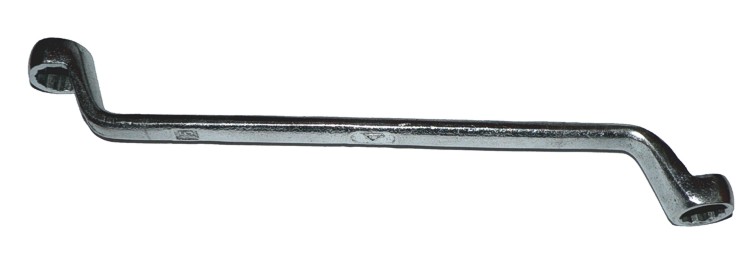|
Bolt (fastener)
A bolt is an externally helical threaded fastener capable of being tightened or released by a twisting force ( torque) to a matching nut. The bolt has an external male thread requiring a matching nut with a pre-formed female thread. History Nuts and bolts were originally hand-crafted together, so that each nut matched its own bolt, but they were not interchangeable. This made it virtually impossible to replace lost or damaged fixers, as they were all different. Joseph Whitworth in 1841 proposed that a standard should be set, but it did not happen immediately. In 1851 the Great Exhibition of the Works of Industry of All Nations was to be held in Hyde Park, London, England, and it was decided to build the Crystal Palace as part; this had to be done in 190 days, and at reasonable cost. Research into the remains of the destroyed building in 2024 revealed a major innovation that made this possible. The construction firm responsible, Fox Henderson, decided to use nuts and bo ... [...More Info...] [...Related Items...] OR: [Wikipedia] [Google] [Baidu] |
Washer (hardware)
A washer is a thin plate (typically disk-shaped, but sometimes square) with a hole (typically in the middle) that is normally used to distribute the load of a threaded fastener, such as a Bolt (fastener), bolt or Nut (hardware), nut. Other uses are as a spacer, spring (Belleville washer, wave washer), wear pad, preload (engineering), preload indicating device, locking device, and to reduce vibration (rubber washer). Washers are usually metal or plastic. High-quality bolted joints require hardened steel washers to prevent the loss of pre-load due to brinelling after the torque is applied. Washers are also important for preventing galvanic corrosion, particularly by insulating steel screws from aluminium surfaces. They may also be used in rotating applications, as a bearing. A ''thrust washer'' is used when a rolling element bearing is not needed either from a cost-performance perspective or due to space restraints. Coatings can be used to reduce wear and friction, either by hardeni ... [...More Info...] [...Related Items...] OR: [Wikipedia] [Google] [Baidu] |
Anchor Bolt
Anchor bolts are used to connect structural and non-structural elements to concrete.. The connection can be made by a variety of different components: anchor bolts (also named fasteners), steel plates, or stiffeners. Anchor bolts transfer different types of load: tension forces and shear forces. A connection between structural elements can be represented by steel columns attached to a reinforced concrete foundation. A common case of a non-structural element attached to a structural one is the connection between a facade system and a reinforced concrete wall. Types Cast-in-place The simplest – and strongest – form of anchor bolt is cast-in-place, with its embedded end consisting of a standard hexagonal head bolt and washer, 90-bend, or some sort of forged or welded flange (see also stud welding). The last are used in concrete-steel composite structures as shear connectors. Other uses include anchoring machines to poured concrete floors and buildings to their ... [...More Info...] [...Related Items...] OR: [Wikipedia] [Google] [Baidu] |
Bolt And Nut, Annotated
Bolt or bolts may refer to: Implements and technology ''Etymology: "to strike", see for example Thunderbolt'' * Bolt (fastener), a threaded shaft, used to clamp two components together * Bolt (climbing), an anchor point used in rock climbing * Bolt (firearms), a mechanism used in firearms * Crossbow bolt, ammunition used in a crossbow * Spy bolt, a clandestine storage device Arts, entertainment, and media * ''Bolt'' (1994 film), a drama starring Richard Grieco * ''Bolt'' (2008 film), a Disney animated film ** Bolt (Disney character), the main character of the film ** ''Bolt'' (video game), based on the film * Bolt (DC Comics), a fictional supervillains and superheroes from DC Comics * ''Bolt'' (1986), a book by Dick Francis * B.O.L.T, a Japanese girl group * ''The Bolt'' (Fragonard), a painting by Jean-Honoré Fragonard * ''The Bolt'' (Shostakovich), a three-act ballet by Dmitri Shostakovich * The Bolts, an American independent rock band Businesses and organizations * ... [...More Info...] [...Related Items...] OR: [Wikipedia] [Google] [Baidu] |
Machine Screw
A screw is an externally helical threaded fastener capable of being tightened or released by a twisting force (torque) to the head. The most common uses of screws are to hold objects together and there are many forms for a variety of materials. Screws might be inserted into holes in assembled parts or a screw may form its own thread. The difference between a screw and a bolt is that the latter is designed to be tightened or released by torquing a nut. The screw head on one end has a slot or other feature that commonly requires a tool to transfer the twisting force. Common tools for driving screws include screwdrivers, wrenches, coins and hex keys. The head is usually larger than the body, which provides a '' bearing surface'' and keeps the screw from being driven deeper than its length; an exception being the ''set screw'' (aka grub screw). The cylindrical portion of the screw from the underside of the head to the tip is called the ''shank''; it may be fully or part ... [...More Info...] [...Related Items...] OR: [Wikipedia] [Google] [Baidu] |
Torx
Torx (pronounced ) is a trademark for a type of screw drive characterized by a 6-point star-shaped pattern, developed in 1967, Bernard F. Reiland, "Coupling arrangement and tools for same", filed 1967-03-21 by Camcar Textron. A popular generic name for the drive is ''star'', as in star screwdriver or star bits. The official generic name, standardized by the International Organization for Standardization as ISO 10664, is hexalobular internal. This is sometimes abbreviated in databases and catalogs as 6lobe (starting with the numeral ''6'', not the capital letter ''G''). Torx Plus, Torx Paralobe and Torx ttap are improved head profiles. Torx screws are commonly found on automobiles, motorcycles, bicycle brake systems ( disc brakes), hard disk drives, computer systems and consumer electronics. Initially, they were sometimes used in applications requiring tamper resistance, since the drive systems and screwdrivers were not widely available. However, as torx drivers became mor ... [...More Info...] [...Related Items...] OR: [Wikipedia] [Google] [Baidu] |
Hex Key
A hex key (also, hex wrench, Allen key and Allen wrench, Unbrako or Inbus) is a simple driver for Bolt (fastener), bolts or screws that have heads with ''internal'' hexagonal recesses (Socket wrench, sockets). Hex keys are formed from a single piece of hard hexagonal steel rod, having blunt ends that fit snugly into similarly shaped screw sockets. The rods are bent to 90°, forming two arms of unequal length resembling an "L". The tool is usually held and twisted by its long arm, creating a relatively large torque at the tip of the short arm; it can also be held by its short arm to access screws in difficult-to-reach locations and to turn screws faster at the expense of torque. Hex keys are designated with a socket size and are manufactured with tight tolerances. As such, they are commonly sold in kits that include a variety of sizes. Key length typically increases with size but not necessarily proportionally so. Variants on this design have the short end inserted in a trans ... [...More Info...] [...Related Items...] OR: [Wikipedia] [Google] [Baidu] |
Coach Screw
A screw is an externally helical threaded fastener capable of being tightened or released by a twisting force (torque) to the screw head, head. The most common uses of screws are to hold objects together and there are many forms for a variety of materials. Screws might be inserted into holes in assembled parts or a screw may form its own thread. The #Differentiation between bolt and screw, difference between a screw and a bolt is that the latter is designed to be tightened or released by torquing a Nut (hardware), nut. The screw head on one end has a slot or other feature that commonly requires a tool to transfer the twisting force. Common tools for driving screws include screwdrivers, wrenches, coins and hex keys. The head is usually larger than the body, which provides a ''bearing surface'' and keeps the screw from being driven deeper than its length; an exception being the ''set screw'' (aka grub screw). The cylindrical portion of the screw from the underside of the head t ... [...More Info...] [...Related Items...] OR: [Wikipedia] [Google] [Baidu] |
Socket Wrench
A socket wrench (or socket spanner) is a type of spanner (or wrench in North American English) that uses a closed ''socket'' format, rather than a typical open wrench/spanner to turn a fastener, typically in the form of a nut or bolt. The most prevalent form is the ratcheting socket wrench, often informally called a ratchet. A ratchet incorporates a reversible ratcheting mechanism which allows the user to pivot the tool back and forth to turn its socket instead of removing and repositioning a wrench to do so. Other common methods of driving sockets include pneumatic impact wrenches, hydraulic torque wrenches, torque multipliers and breaker bars. Some lesser known hybrid drivers include striking wrench tools with square drive, and hydraulic impact wrenches (typically powered by on site hydraulic power such as present with military tanks, and many rail car applications). Interchangeable sockets The basic contemporary form of socket is hexagonal, referred to as "6-point" for ... [...More Info...] [...Related Items...] OR: [Wikipedia] [Google] [Baidu] |
Spanner
A wrench or spanner is a tool used to provide grip and mechanical advantage in applying torque to turn objects—usually rotary fasteners, such as Nut (hardware), nuts and screw, bolts—or keep them from turning. In the United Kingdom, UK, Ireland, Australia, and New Zealand ''spanner'' is the standard term. The most common shapes are called ''open-ended spanner'' and ''ring spanner''. The term ''wrench'' is generally used for tools that turn non-fastening devices (e.g. tap wrench and pipe wrench), or may be used for a monkey wrench—an adjustable pipe wrench. In North American English, ''wrench'' is the standard term. The most common shapes are called ''open-end wrench'' and ''box-end wrench''. In American English, ''spanner'' refers to a specialized wrench with a series of pins or tabs around the circumference. (These pins or tabs fit into the holes or notches cut into the object to be turned). In American commerce, such a wrench may be called a ''spanner wrench'' to dis ... [...More Info...] [...Related Items...] OR: [Wikipedia] [Google] [Baidu] |
Forging
Forging is a manufacturing process involving the shaping of metal using localized compression (physics), compressive forces. The blows are delivered with a hammer (often a power hammer) or a die (manufacturing), die. Forging is often classified according to the temperature at which it is performed: cold forging (a type of cold working), warm forging, or hot forging (a type of hot working). For the latter two, the metal is heated, usually in a forge. Forged parts can range in weight from less than a kilogram to hundreds of metric tons.Degarmo, p. 389 Forging has been done by metalsmith, smiths for millennia; the traditional products were kitchenware, household hardware, hardware, hand tools, edged weapons, cymbals, and jewellery. Since the Industrial Revolution, forged parts are widely used in mechanism (engineering), mechanisms and machines wherever a component requires high strength of materials, strength; such forgings usually require further processing (such as machining) ... [...More Info...] [...Related Items...] OR: [Wikipedia] [Google] [Baidu] |
Carriage Bolt
A carriage bolt (also called coach bolt and round-head square-neck bolt) is a type of Bolt (fastener), bolt. It is also known as a cup head bolt in Australia and New Zealand. It is distinguished from other bolts by its shallow Screw#Truss head, mushroom head and the fact that the cross-section of the shank, though circular for most of its length (as in other kinds of bolt), is square immediately beneath the head. This makes the bolt self-locking when it is placed through a square hole in a metal strap. This allows the fastener to be installed with only one wrench, working from the opposite end. The head of a carriage bolt is usually a shallow dome. The shank has no threads and its diameter equals the size of the square cross-section. The carriage bolt was devised for use through an iron strengthening plate on either side of a wooden beam, the squared part of the bolt fitting into a square hole in the ironwork. It is also not uncommon to use a carriage bolt on bare timber, the squ ... [...More Info...] [...Related Items...] OR: [Wikipedia] [Google] [Baidu] |








